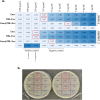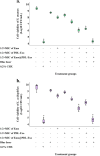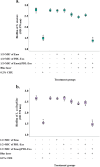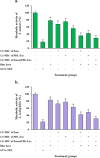Periodontal ligament stem cell-derived exosome-loaded Emodin mediated antimicrobial photodynamic therapy against cariogenic bacteria
- PMID: 38454402
- PMCID: PMC10919019
- DOI: 10.1186/s12903-024-04062-7
Periodontal ligament stem cell-derived exosome-loaded Emodin mediated antimicrobial photodynamic therapy against cariogenic bacteria
Abstract
Background: This study was conducted to investigate the efficiency of periodontal ligament (PDL) stem cell-derived exosome-loaded Emodin (Emo@PDL-Exo) in antimicrobial photodynamic therapy (aPDT) on Streptococcus mutans and Lactobacillus acidophilus as the cariogenic bacteria.
Materials and methods: After isolating and characterizing PDL-Exo, the study proceeded to prepare and verify the presence of Emo@PDL-Exo. The antimicrobial effect, anti-biofilm activity, and anti-metabolic potency of Emo, PDL-Exo, and Emo@PDL-Exo were then evaluated with and without irradiation of blue laser at a wavelength of 405 ± 10 nm with an output intensity of 150 mW/cm2 for a duration of 60 s. In addition, the study assessed the binding affinity of Emodin with GtfB and SlpA proteins using in silico molecular docking. Eventually, the study examined the generation of endogenous reactive oxygen species (ROS) and changes in the gene expression levels of gelE and sprE.
Results: The study found that using Emo@PDL-Exo-mediated aPDT resulted in a significant decrease in L. acidophilus and S. mutans by 4.90 ± 0.36 and 5.07 log10 CFU/mL, respectively (P < 0.05). The study found that using Emo@PDL-Exo for aPDT significantly reduced L. acidophilus and S. mutans biofilms by 44.7% and 50.4%, respectively, compared to untreated biofilms in the control group (P < 0.05). Additionally, the metabolic activity of L. acidophilus and S. mutans decreased by 58.3% and 71.2%, respectively (P < 0.05). The molecular docking analysis showed strong binding affinities of Emodin with SlpA and GtfB proteins, with docking scores of -7.4 and -8.2 kcal/mol, respectively. The study also found that the aPDT using Emo@PDL-Exo group resulted in the most significant reduction in gene expression of slpA and gtfB, with a decrease of 4.2- and 5.6-folds, respectively, compared to the control group (P < 0.05), likely due to the increased generation of endogenous ROS.
Discussion: The study showed that aPDT using Emo@PDL-Exo can effectively reduce the cell viability, biofilm activity, and metabolic potency of S. mutans and L. acidophilus. aPDT also significantly reduced the expression levels of gtfB and slpA mRNA due to the increased endogenous ROS generation. The findings suggest that Emo@PDL-Exo-mediated aPDT could be a promising antimicrobial approach against cariogenic microorganisms.
Keywords: Antimicrobial photodynamic therapy; Bioinformatics tools; Emodin; Exosome.
© 2024. The Author(s).
Conflict of interest statement
The authors declare no competing interests.
Figures










Similar articles
-
Theranostic nanoplatforms of emodin-chitosan with blue laser light on enhancing the anti-biofilm activity of photodynamic therapy against Streptococcus mutans biofilms on the enamel surface.BMC Microbiol. 2022 Mar 4;22(1):68. doi: 10.1186/s12866-022-02481-6. BMC Microbiol. 2022. PMID: 35246026 Free PMC article.
-
Evaluation of anti-biofilm effect of antimicrobial sonodynamic therapy-based periodontal ligament stem cell-derived exosome-loaded kojic acid on Enterococcus faecalis biofilm.J Med Microbiol. 2023 Nov;72(11). doi: 10.1099/jmm.0.001772. J Med Microbiol. 2023. PMID: 37910015
-
Postbiotic mediators derived from Lactobacillus species enhance riboflavin-mediated antimicrobial photodynamic therapy for eradication of Streptococcus mutans planktonic and biofilm growth.BMC Oral Health. 2024 Jul 24;24(1):836. doi: 10.1186/s12903-024-04620-z. BMC Oral Health. 2024. PMID: 39048998 Free PMC article.
-
Effect of curcumin-mediated photodynamic therapy on Streptococcus mutans and Candida albicans: A systematic review of in vitro studies.Photodiagnosis Photodyn Ther. 2019 Sep;27:455-461. doi: 10.1016/j.pdpdt.2019.07.010. Epub 2019 Jul 25. Photodiagnosis Photodyn Ther. 2019. PMID: 31352059
-
The effect of photodynamic therapy in controlling the oral biofilm: A comprehensive overview.J Basic Microbiol. 2023 Dec;63(12):1319-1347. doi: 10.1002/jobm.202300400. Epub 2023 Sep 19. J Basic Microbiol. 2023. PMID: 37726220 Review.
Cited by
-
Investigating the Effect of Photodynamic Therapy With a 660 nm Laser With Methylene Blue and Cold Atmospheric Plasma Therapy on Streptococcus sanguinis.J Lasers Med Sci. 2025 Mar 11;16:e7. doi: 10.34172/jlms.2025.07. eCollection 2025. J Lasers Med Sci. 2025. PMID: 40666250 Free PMC article.
-
Mechanistic insights into periodontal ligament stem cell-derived exosomes in tissue regeneration.Clin Oral Investig. 2025 Jun 25;29(7):357. doi: 10.1007/s00784-025-06422-1. Clin Oral Investig. 2025. PMID: 40562987 Free PMC article. Review.
-
Isolation methods of exosomes derived from dental stem cells.Int J Oral Sci. 2025 Jun 16;17(1):50. doi: 10.1038/s41368-025-00370-y. Int J Oral Sci. 2025. PMID: 40523888 Free PMC article. Review.
References
-
- Cogulu D, Saglam C. Genetic aspects of dental caries. Frontiers in Dental Medicine. 2022;3:1060177. doi: 10.3389/fdmed.2022.1060177. - DOI
MeSH terms
Substances
LinkOut - more resources
Full Text Sources
Molecular Biology Databases

